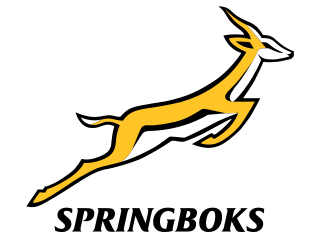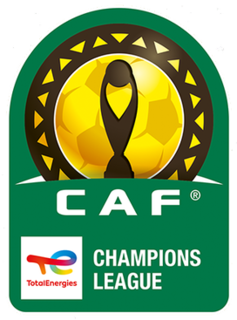
The CAF Africa Cup of Nations, officially CAN, also referred to as AFCON, or Total Africa Cup of Nations after its headline sponsor, is the main international men's association football competition in Africa. It is sanctioned by the Confederation of African Football (CAF), and was first held in 1957. Since 1968, it has been held every two years, switching to odd-numbered years in 2013.

The South Africa national rugby union team, commonly known as the Springboks, is the country's national team governed by the South African Rugby Union. The Springboks play in green and gold jerseys with white shorts, and their emblem is the native antelope springbok. The team has been representing South Africa in international rugby union since 30 July 1891, when they played their first test match against a British Isles touring team.

Augustine Azuka "Jay-Jay" Okocha is a Nigerian former professional footballer who played as an attacking midfielder.

The Confederation of African Football or CAF is the administrative and controlling body for African association football.

The Cameroon national football team, represents Cameroon in men's international football and It is controlled by the Fédération Camerounaise de Football. The team has qualified seven times for the FIFA World Cup, more than any other African team. However, the team has only made it once out of the group stage. They were the first African team to reach the quarter-final of the FIFA World Cup in 1990, losing to England in extra time. They have also won five Africa Cup of Nations and Olympic gold in 2000. The team represents Cameroon both in FIFA and Confederation of African Football (CAF).

The South Africa national football team represents South Africa in men's international soccer and it is run by the South African Football Association, the governing body for Soccer in South Africa. The team's nickname is Bafana Bafana, and South Africa's home ground is FNB Stadium, which is located in Johannesburg. The team's greatest result was winning the Africa Cup of Nations at home in 1996. The team is a member of both FIFA and Confederation of African Football (CAF).
The Egypt national football team, known colloquially as "the Pharaohs", represents in men's international football, and is governed by the Egyptian Football Association (EFA), the governing body of football in Egypt. The team's historical stadium is Cairo International Stadium, although matches are sometimes played at Borg El Arab Stadium in Alexandria.

The Ghana national football team represents Ghana in men's international football and has done so since the 1950s. The team consists of twenty players including the technical team. The team is nicknamed the Black Stars after the Black Star of Africa in the flag of Ghana. It is governed by the Ghana Football Association(GFA) the governing body for football in Ghana and the oldest football association in Africa. Prior to 1957, the team played as the Gold Coast. The team is a member of both FIFA and CAF.

The Tunisia national football team represents Tunisia in men's international football since their maiden match in 1957. It is governed by the Tunisian Football Federation, founded in 1957 after the Tunisian independence in 1956. Tunisia are colloquially known as The Eagles of Carthage. The team's colours are red and white, and the Bald eagle its symbol. There have been periods of regular Tunisian representation at the highest international level: from 1962 to 1978, from 1994 to 2008 and again from 2014 onwards. Most of Tunisia's home matches are played at the Stade Hammadi Agrebi in Radès since 2001. The team represents both FIFA and the Confederation of African Football (CAF).

The DR Congo national football team, recognised by FIFA as Congo DR, represents the Democratic Republic of the Congo in men's international football and it is controlled by the Congolese Association Football Federation. They are nicknamed the Leopards. The team is a member of FIFA and the Confederation of African Football (CAF).
The Mali national football team represents Mali in men's international football and is governed by the Malian Football Federation. The team's nickname is Les Aigles. They represent both FIFA and the Confederation of African Football (CAF).

The Guinea national football team represents Guinea in men's international football and it is controlled by the Guinean Football Federation. They have never qualified for the FIFA World Cup finals, and their best finish in the Africa Cup of Nations was runners-up in 1976. The team reached the quarter-finals in four recent tournaments. The team represents both FIFA and Confederation of African Football (CAF).

The Angola national football team represents Angola in men's international football and is controlled by the Angolan Football Federation. The team made its first appearance in 2006 FIFA World Cup, the team's nickname is Palancas Negras, The team is governing body of Football in Angola in the country, The team represents both FIFA and Confederation of African Football (CAF).

The Ethiopia national football team, nicknamed Walias, after the Walia ibex, represents Ethiopia in men's international football and is controlled by the Ethiopian Football Federation, the governing body for football in Ethiopia. The team has been representing Ethiopia in regional, continental, and international competitions since its founding in 1943. The Walias play their home games at Addis Ababa Stadium located in the capital city of Addis Ababa. They are currently ranked 150th in the world according to the FIFA World Rankings and 44th in CAF.
The 2004 African Cup of Nations, known as the NOKIA African Cup of Nations, Tunisia 2004 for sponsorship reasons, was the 24th edition of the Africa Cup of Nations, the biennial international men's football championship of Africa organized by the Confederation of African Football (CAF).

The CAF Champions League is an annual continental club football competition run by the CAF. The top club sides from Africa's football leagues are invited to participate in this competition. Due to sponsorship reasons, the official name is TotalEnergies CAF Champions League.

The CAF Confederation Cup, officially named TotalEnergies CAF Confederation Cup, is an annual club association football competition organised by the CAF since 2004. Clubs qualify for the competition based on their performance in their national leagues and cup competitions. It is the second-tier competition of African club football, ranking below the CAF Champions League. The winner of the tournament faces the winner of the CAF Champions League in the following season's CAF Super Cup.

The CAF Super Cup is an annual African association football competition contested between the winners of the CAF Champions League and the CAF Confederation Cup. The competition was first held in 1993 and is organized by the CAF.

Hervé Renard is a French football coach and former professional player who is the manager of Saudi Arabia.

The Namibia national cricket team, nicknamed the Eagles, is the men's team that represents the Republic of Namibia in international cricket. It is organised by Cricket Namibia which became an associate member of the International Cricket Council (ICC) in 1992.
















